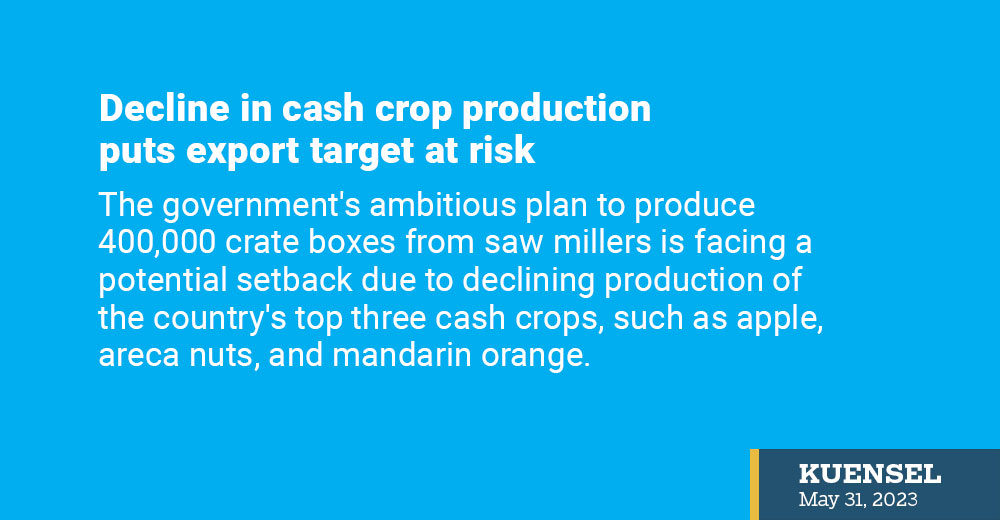
The government’s ambitious plan to produce 400,000 crate boxes from various saw millers to meet export requirements is facing a potential setback as the production of the country’s top three cash crops, namely apple, areca nuts, and mandarin orange, has declined.
According to the 2022 Integrated Agriculture and Livestock Census (IALC) report published by the National Statistics Bureau (NSB), a total of 38,086 metric tonnes of fruits were harvested in 2022. Of this, 31,796 metric tonnes consisted of major fruits such as apple, mandarin orange, and areca nuts, while the remaining 69 metric tonnes were newly promoted fruits such as watermelon, kiwi, and dragon fruit.
Fruits and vegetables are being advocated as major sources of dietary fibre. Increased intake of dietary fiber has been shown to significantly reduce the risk of non-communicable diseases such as high cholesterol, triglyceride levels, and high blood pressure.
Apple, mandarin, and areca nut are the leading cash crops among the fruit crops grown in Bhutan.
The major apple-producing dzongkhags identified by the 2022 IALC report are Paro, Thimphu, Haa, and Bumthang. Similarly, the dominant areca nut-producing dzongkhags are Samtse, Sarpang, and Chhukha, while mandarin production is prominent in Dagana, Tsirang, Zhemgang, and Pemagatshel.
Apple
In 2022, total of 2,223 metric tonnes of apples were harvested, which was 101 metric tonnes less than in 2021. The yield per bearing tree of apples was recorded at 19 kg in 2022, an increase of more than 1 kg compared to the previous year. Paro harvested 1,558 metric tonnes of apples (47 metric tonnes more than in 2021), while Thimphu harvested 465 metric tonnes (112 metric tonnes less than in 2021).
Paro recorded a yield per bearing tree of 22 kg (5 kg more than in 2021), while Thimphu recorded a yield of 12 kg (8 kg less than in 2021).
The decrease in apple production in 2022 was attributed to a reduction in bearing trees, totaling 119,688 (14,316 fewer trees than in 2021), with Thimphu alone accounting for 9,231 in reduction. However, the number of apple growers increased from 5,262 households in 2021 to 7,390 households in 2022.
Areca nut
In 2022, about 11,106 metric tonnes of areca nuts were harvested, which was 10,271 metric tonnes (52 percent) less than in 2021. The yield per bearing tree of areca nuts was recorded at 8 kg in 2022, a decrease of 4 kg compared to the previous year.
The major areca nut-producing dzongkhags—Samtse, Sarpang, and Samdrupjongkhar—harvested 3,630 metric tonnes, 4,853 metric tonnes, and 689 metric tonnes, respectively. In terms of yield per bearing tree, Samtse recorded 8kg (8 kg less than in 2021), Sarpang recorded 8 kg (1 kg less than in 2021), and Samdrupjongkhar recorded 10 kg (6 kg less than in 2021).
The decrease in national areca nut production in 2022 was attributed to a decrease in the number of bearing trees, which totaled 1,415,779 (377,473 fewer trees than in 2021).
Samtse accounted for more than three-fourths of the total reduction in bearing trees with a decrease of 292,563 trees. The number of growers remained almost the same, with 11,357 households in 2022 compared to 11,355 households in 2021.
Mandarin orange
Mandarin orange is one of Bhutan’s largest fresh fruit exports to India and Bangladesh, contributing significantly to the economy. However, mandarin growers continue to face numerous constraints despite support from the Ministry of Agriculture and Livestock in terms of orchard management, diversification of varieties, and the development of processing and nurseries.
The decline in mandarin production is attributed to climate change impacts, increased pest and disease outbreaks, drought, erratic rainfall, and limited knowledge of farm management.
In 2022, total of 18,467 metric tonnes of mandarins were harvested, an increase of 2,500 metric tonnes compared to 2021. The yield per bearing tree of mandarins was recorded at 26 kg in 2022, an increase of six kg compared to the previous year.
The major mandarin orange-producing dzongkhags—Dagana, Samdrup Jongkhar, and Tsirang—harvested 3,487 metric tonnes, 2,638 metric tonnes, and 3,056 metric tonnes, respectively.
Dagana recorded a yield per bearing tree of 27 kg (6 kg more than in 2021), Samdrupjongkhar recorded 28 kg (5 kg more than in 2021), and Tsirang recorded 43 kg (14 kg more than in 2021).
The higher level of mandarin production in 2022 was due to the higher yield per bearing tree. The number of mandarin growers increased from 21,904 households in 2021 to 23,817 households in 2022.
Last year, Bhutan exported mandarin orange worth Nu 418.23 million (M) to India and Bangladesh. Additionally, apples worth Nu 21.05M was exported to India and other countries in 2022.
India has recently permitted the import of green (raw) areca nuts from Bhutan without imposing a minimum import price (MIP), which was previously set at Nu 251 per kg. With this agreement, Bhutan can annually export 17,000 metric tonnes of fresh areca nut to the Indian market.
As cash crop production faces a decline, achieving the export target of 400,000 boxes from saw millers is becoming increasingly challenging.
The government and relevant authorities must address the factors contributing to the decline and provide the necessary support to the farmers to revive cash crop production and sustain the country’s export industry.












